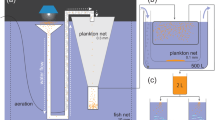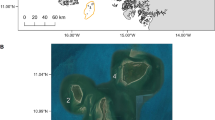Abstract
Most of the known food webs are based on organic compounds provided by photoautotrophic organisms. The terrestrial ecosystem of Malpelo Island (Colombia) seems to be an exception, however, since it supports several trophic guilds without hosting an adequate amount of primary producers. It has been suggested that this apparent paradox might be explained by external inputs provided by seabirds, namely Nazca Boobies (Sula granti), forming a huge colony on Malpelo. This hypothesis has never been tested. Here, we present a first approach to quantify the significance of Nazca Booby inputs into the Malpelo ecosystem via excrement, second eggs/chicks (which are prone to die), and carcasses, respectively, during the major breeding season. The total input was calculated to amount to 171.6 t per breeding season, with excrements accounting for almost 99% (170 t) of this input. Second eggs/chicks contributed approximately 1.1 t (0.64%) and carcasses around 0.1 t (0.06%). These finding support the idea of the Nazca Booby facilitating a food chain that pairs the pelagic primary producers of the open ocean with the terrestrial consumers of an island. Species most strongly profiting from this process include three endemic lizard species (Anolis agassizi, Diploglossus millepunctatus, Phyllodactylus transversalis) and the land crab (Johngarthia malpilensis).

Similar content being viewed by others
References
Anderson DJ (1989) The role of hatching asynchrony in siblicidal brood reduction of two booby species. Behav Ecol Sociobiol 25:363–368. doi:10.1007/BF00302994
Anderson DJ (1993) Masked booby (Sula dactylatra). In: Poole A, Gill F (eds) The birds of North America, No 73. The Birds of North America, Philadelphia, PA
Anderson DJ (1996) The role of parents in siblicidal brood reduction of two boobies species. Auk 112:860–869
Anderson WB, Polis GA (1999) Nutrient fluxes from water to land: seabirds affect plant nutrient status on Gulf of California islands. Oecologia 118:324–332. doi:10.1007/s004420050733
Anderson WB, Polis GA (2004) Allochthonous nutrient and food inputs: consequences for temporal stability. In: Polis GA, Power ME, Huxel GR (eds) Food webs: at the landscape level. University of Chicago Press, Chicago, pp 82–95
Anderson DJ, Ricklefs RE (1992) Brood size and food provisioning in masked and blue: footed boobies (Sula spp.). Ecology 73:1363–1374. doi:10.2307/1940682
Bartholomew GA (1966) The role of behaviour in the temperature regulation of the masked booby. Condor 68:523–535. doi:10.2307/1366261
Begon M, Harper JL, Townsend CR (1996) Ecology: individuals, populations and communities. Blackwell, Oxford, pp 731–736
Campbell JW (1995) Excretory nitrogen metabolism in reptiles and birds. In: Walsh PJ, Wright P (eds) Nitrogen metabolism and excretion. CRC Press, New York, pp 147–178
Ellis JC (2005) Marine birds on land: a review of plant biomass, species richness, and community composition in seabird colonies. Plant Ecol 181:227–241. doi:10.1007/s11258-005-7147-y
García S, López-Victoria M (2007) Ecología trófica del Piquero de Nazca (Sula granti) en la Isla Malpelo. Bol Invest Mar Cost 36:7–30
Heatwole H (1971) Marine-dependent terrestrial biotic communities on some cays in the Coral Sea. Ecology 52:363–366. doi:10.2307/1934598
Hutchinson GE (1950) Survey of contemporary knowledge of biogeochemistry 3. The biogeochemistry of vertebrate excretion. Bull Am Mus Nat Hist 96:1–554
Jordan R (1961) Las aves guaneras, la cadena alimentaria y la producción de guano. Col Comp Admin Guano 37:19–20
Kiester AR (1975) Notes on the natural history of Diploglossus millepunctatus (Sauria: Anguidae). Smithson Contrib Zool 176:39–43
Lindeboom HJ (1984) The nitrogen pathway in a penguin rookery. Ecology 65:269–277. doi:10.2307/1939479
López-Victoria M, Estela FA (2007) Aspectos sobre la ecología del Piquero de Nazca Sula granti en la isla Malpelo. In: DIMAR–CCCP & UAESPNN–DTSO (Hrsg) Santuario de Fauna y Flora Malpelo: descubrimiento en marcha. DIMAR, Bogotá, pp 131–142
López-Victoria M, Rozo D (2006) Model: based geomorphology of Malpelo Island and spatial distribution of breeding seabirds. Bol Invest Mar Cost 35:111–131
López-Victoria M, Rozo D (2007) Wie viele Nazcatölpel (Sula granti) brüten auf der Insel Malpelo? Vogelwarte 45:365–366
López-Victoria M, Werding B (2008) Ecology of the endemic land crab Johngarthia malpilensis (Decapoda: Brachyura: Gecarcinidae), a poorly known species from the Tropical Eastern Pacific. Pac Sci 62:483–493. doi:10.2984/1534-6188(2008)62[483:EOTELC]2.0.CO;2
Odum E (1971) Fundamentals of Ecology. Saunders, Philadelphia
Polis GA, Hurd SD (1996) Allochthonous input across habitats, subsidized consumers and apparent trophic cascades: examples from the ocean-land interface. In: Polis GA, Winemiller K (eds) Food webs: integration of patterns and dynamics. Chapman & Hall, New York, pp 275–285
Polis GA, Anderson WB, Holt RD (1997) Toward an integration of landscape and food web ecology: the dynamics of spatially subsidized food webs. Annu Rev Ecol Syst 28:289–316. doi:10.1146/annurev.ecolsys.28.1.289
Polis GA, Sánchez-Piñero F, Stapp PT, Anderson WB, Rose MD (2004) Trophic flows from water to land: marine input affects food webs of island and coastal ecosystems worldwide. In: Polis GA, Power ME, Huxel GR (eds) Food webs: at the landscape level. University of Chicago Press, Chicago, pp 200–216
Rand AS, Gorman GC, Rand WM (1975) Natural history, behavior, and ecology of Anolis agassizi. Smithson Contrib Zool 176:27–38
Ricklefs RE (1990) Ecology. WH Freeman and Company, New York, pp 189–209
Sánchez-Piñero F, Polis GA (2000) Bottom-up dynamics of allochthonous input: direct and indirect effects of seabirds on islands. Ecology 81:3117–3132
Stapp PT, Polis GA, Sánchez-Piñero F (1999) Stable isotopes reveal strong marine and El Niño effects on island food webs. Nature 401:467–469. doi:10.1038/46769
Ueno Y, Hori M, Noda T, Mukai H (2006) Effects of material inputs by the grey heron Ardea cinerea on forest floor necrophaugous insects and understory plants in the breeding colony. Ornithol Sci 5:199–209
von Prahl H (1990) Malpelo la roca viviente. FEN Colombia, Editorial Presencia, Bogotá
Wolda H (1975) The ecosystem on Malpelo Island. Smithson Contrib Zool 176:21–26
Acknowledgments
This investigation was partially supported by the Marine and Coastal Research Institute–INVEMAR, the Colombian Institute for the Development of Science and Technology–COLCIENCIAS (Project 2105091352703), the Department of Animal Ecology at the Justus–Liebig–University of Giessen and the German Academic Exchange Service. Further support was provided by the Special Administrative Unit for the System of National Natural Parks of Colombia, the Malpelo Foundation, the National Navy of Colombia and Idea Wild. We are grateful to F.A. Estela, R.L. Pitman and D. Anderson for providing us with some of their field observations on boobies and land crabs. We are also grateful to P.H. Becker and the referees for comments and suggestions that greatly contributed to improve this manuscript. This is contribution #1030 of INVEMAR.
Author information
Authors and Affiliations
Corresponding author
Additional information
Communicated by P. H. Becker.
Rights and permissions
About this article
Cite this article
López-Victoria, M., Wolters, V. & Werding, B. Nazca Booby (Sula granti) inputs maintain the terrestrial food web of Malpelo Island. J Ornithol 150, 865–870 (2009). https://doi.org/10.1007/s10336-009-0407-1
Received:
Revised:
Accepted:
Published:
Issue Date:
DOI: https://doi.org/10.1007/s10336-009-0407-1




